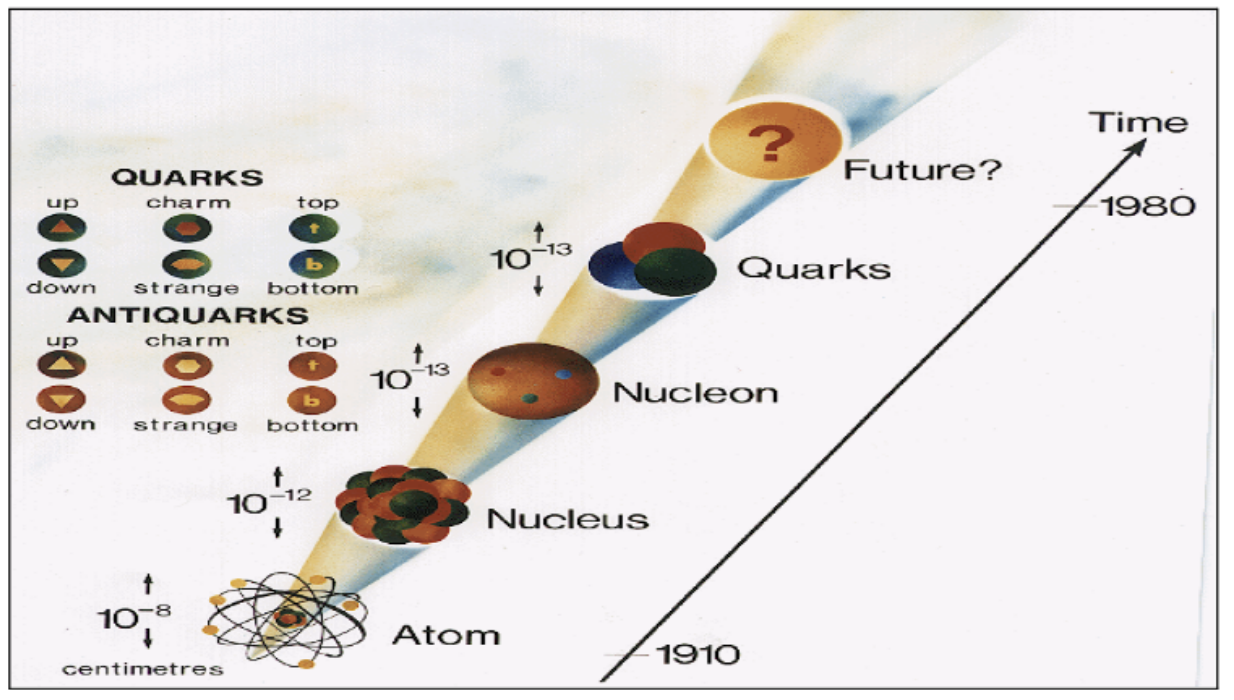News Excerpt:
Scientists at the world’s largest physics experiment (Large Hadron Collider) have reported the most precise measurement yet of the “Top Quark”. By precisely measuring the top quark's mass, physicists hope to gain significant insights into the Higgs boson.
More about the News:
- The Greek philosopher Empedocles surmised 2,400 years ago that matter could be broken up into smaller and smaller pieces until we’re left with air, earth, fire, and water.
- Since the early 20th century, physicists have broken up matter into smaller and smaller pieces to find many different subatomic particles.
The top quark:
- More energetic particles often break down into ones with less energy.
- The greater the difference in energy between that of a particle and the products of its decay, the less time the particle exists in its original form and the more quickly it breaks down.
- By the mass-energy equivalence (E = mc2), a more massive particle is also a more energetic particle. And the most massive particle scientists have found to date is the top quark. It is 10 times heavier than a water molecule.
- As a result, the top quark is so unstable that it could break up into lighter, more stable particles in less than 10−25 seconds.
- The top quark's mass is very important in physics. A particle's mass is equal to the sum of masses contributed from multiple sources.
- An important source for all elementary particles is the Higgs field, which pervades the entire universe.
Higgs field and particles:
- A 'field' is like a sea of energy and excitations in the field are called particles.
- For example, an excitation of the Higgs field is called the Higgs boson just as an electron can be considered to be an excitation of an 'electron field'.
- The top quark is the most massive subatomic particle because it interacts most strongly with Higgs bosons.
- Physicists are intrigued by the top quark mass due to its peculiarities:
- It is the one closest to the Higgs boson’s mass, which seems natural before measuring it, yet all other similar particles are much lighter, raising questions about whether the top quark is an anomaly.
The universe as we know it
- Physicists study the Higgs boson also because of its own mass, which it acquires by interacting with other Higgs bosons.
- The Higgs boson is more massive than expected which is to say the Higgs field is more energy-laden than expected.
- The universe can be said to be more energetic than expected.
- This 'expectation' comes from calculations physicists have performed and Physicists are unsure why the Higgs field has so much energy.
Higgs field theory:
- Physicists also have a theory as to how the Higgs field originally formed (at the birth of the universe). If they are right, there's a small chance the field could self-adjust, lowering its energy and drastically altering the universe.
- They know the field has some potential energy today and there is a way it could shed some of it to have less and become more stable.
- There are two ways to get to this stable state.
- One is for the field to gain some energy first before losing it and more, like climbing one side of a mountain to get into a deeper valley on the other side.
- The other is if an event called quantum tunnelling happens, whereby the field's potential energy would 'tunnel' through the mountain instead of having to climb over it and drop into the valley yonder.
Higgs boson mass significance:
- The Higgs boson's mass — 126 GeV/c2 (a unit used for subatomic particles) — is also just about enough to keep the universe in its current state;
- Now, the physicists would like to know which natural processes contribute to it.
- Measuring the top quark mass has implications for whether our universe will tunnel out of existence.
Finding the top quark
- Physicists discovered the top quark in 1995 at a particle accelerator in the US called the Tevatron, with an initial mass of 151-197 GeV/c2.
- Physicists updated the value three years later to 174.98 GeV/c2.
- On June 27, physicists at the Large Hadron Collider (LHC) in Europe reported the most precise figure yet: 172.52 GeV/c2.
- Measuring a top quark's mass is difficult when its lifetime is around 10-25 seconds.
Conclusion:
- Now researchers will incorporate the top quark’s mass measurement into calculations that inform our understanding of our universe’s particles. Some of them will use it to also quest for an even more precise value.
- Precisely measuring the top quark’s mass is also key to knowing whether some other particle with a mass close to that of the top quark could be hiding in the data.
|



